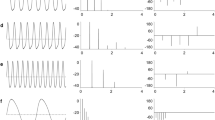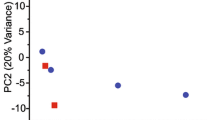Summary
Several species of mormyrid electric fish have a sex difference in the pulse waveform of their electric organ discharge (EOD). Field studies in Gabon, West Africa have shown for one such species,Brienomyrus brachyistius (triphasic), that the sexually mature male EOD differs in shape and is nearly twice the duration of the EODs of females and juveniles. Fourier analysis reveals that differences in EOD duration correlate with those in the EOD power spectrum which has a peak at 0.3 kHz in males and 1.3 kHz in females and juveniles. We find a corresponding sex difference in the frequency tuning of at least one class of electroreceptors known as Knollenorgans. The average ‘best’ or ‘characteristic’ frequency of Knollenorgans is lower in males compared to females and juveniles. This correlates with a lower peak in the power spectrum of the male's pulse. When females are treated with gonadal androgens, their EODs increase 2–3 fold in duration, and the power spectra of their pulses are correspondingly lowered to match that of mature males. The average best frequency of Knollenorgans decreases by nearly 1 kHz which matches the downward shift of their EOD's power spectrum.
For a second species ofBrienomyrus (sp. 2) which is commercially imported from Nigeria, we have not detected a sex difference in the power spectrum or duration of the EOD. The power spectrum peaks at about 4.2 kHz in males, females, and juveniles. Androgens, however, do cause a coincident downward shift in the average peak of the EOD power spectrum (from 4.2 to 1.3 kHz) and the average best frequency of Knollenorgans (from 2.3 to 1.4 kHz).
Specimens ofBrienomyrus (sp. 2) that have been electrically silenced by surgical means are tuned, on the average, only 0.2 kHz higher than control animals. Silenced animals that have been treated with androgens are tuned, on the average, 0.2 kHz below controls. The results suggest that electroreceptor tuning is only partially modifiable during androgen treatment if the electroreceptors arenot being stimulated by an external electrical stimulus, i.e. the animal's own EOD. Since androgen treatment has a dramatic effect on receptor tuningonly in intact fish, it seems likely that retuning isnot due to a direct action of androgens on receptors, but rather due to the action of the principal electrical stimulus upon the receptors, i.e. the EOD. The implications of such results for the development of species and sex differences in electro-receptor tuning is discussed.
Similar content being viewed by others
References
Arnold AP, Nottebohm F, Pfaff DW (1976) Hormone concentrating cells in vocal control and other areas of the brain of the zebra finch (Poephila guttata). J Comp Neurol 165:487–512
Bass AH (1983) Frequency tuning of electroreceptors is lowered in androgen treated mormyrid fishes. Neurosci Abstr 9:532
Bass AH, Hopkins CD (1980) Coding of species-specific signals in mormyrid electric fish. I. Frequency characteristics. Neurosci Abstr. 6:604
Bass AH, Hopkins CD (1982) Gonadal steroids modulate sex differences in an electric organ discharge. Neurosci Abstr 8:931
Bass AH, Hopkins CD (1983) Hormonal control of sexual differentiation: Changes in electric organ discharge waveform. Science 220:971–974
Bass AH, Denizot J-P, Hopkins CD (1983) Electric organ morphology of mormyrids: Substrates for species and sex differences in the electric organ discharge. Anat Rec 205:16A
Bass A, Segil N, Kelley D (1984) A steroid sensitive electromotor pathway in mormyrid fish: Electric organ morphology, androgen receptor biochemistry and steroid autoradiography. Neurosci Abstr 10:927
Bastian J (1976) Frequency response characteristics of electroreceptors in weakly electric fish (Gymnotoidei) with a pulse discharge. J Comp Physiol 112:165–180
Bastian J (1977) Variations in the frequency response of electroreceptors dependent on receptor location in weakly electric fish (Gymnotoidei) with a pulse discharge. J Comp Physiol 121:53–64
Bell CC, Libouban S, Szabo T (1983) Pathways of the electric organ discharge command and its corollary discharges in mormyrid fish. J Comp Neurol 216:327–338
Bennett MVL (1965) Electroreceptors in mormyrids. Cold Spring Harb Symp Quant Biol 30:245–262
Bennett MVL (1971a) Electric organs. In: Hoar WS, Randall DJ (eds) Fish physiology, vol V. Academic Press, NewYork, pp 347–491
Bennett MVL (1971b) Electroreception. In: Hoar WS, Randall DJ (eds) Fish physiology, vol V. Academic Press, New York, pp 493–574
Bennett MVL, Grundfest H (1961) Studies on the morphology and electrophysiology of electric organs. III. Electrophysiology of electric organs in mormyrids. In: Chagas C, Carvalho A (eds) Bioelectrogenesis. Elsevier, London New York Princeton, pp 113–135
Breedlove SM, Arnold AP (1980) Hormone accumulation in a sexually dimorphic motor nucleus in the rat spinal cord. Science 210:564–566
Crawford AC, Fettiplace R (1981) An electrical tuning mechanism in turtle cochlear hair cells. J Physiol (Lond) 312:377–412
Erulkar SD, Kelley D, Jurman J, Zemlan F, Schneider G, Kreiger N (1981) Modulation of the neural control of the clasp reflex in maleXenopus laevis by androgens: A multi-disciplinary study. Proc Natl Acad Sci 78:5876–5880
Fine ML, Keefer DA, Leichnetz GR (1982) Testosterone uptake in the brainstem of a sound-producing fish. Science 215:1265–1267
Greenwood PH, Rosen DE, Weitzman SH, Myers GW (1966) Phyletic studies of teleostean fishes, with a provisional classification of living forms. Bull Am Mus Nat Hist 313:339–456
Hagedorn M, Carr C (1983) Single electrocytes produce a sexually dimorphic signal in electric fish. Neurosci Abstr 9:531
Halpern M, Morrell J, Pfaff DW (1982) Cellular (3H) estradiol and (3H) testosterone localization in the brains of garter snakes: An audioradiographic study. Gen Comp Endocrinol 46:211–224
Hopkins CD (1972) Sex differences in signalling in an electric fish. Science 176:1035–1037
Hopkins CD (1974) Electric communication in fish. Amer Sci 62:426–437
Hopkins CD (1976) Stimulus filtering and electroreception: Tuberous electroreceptors in three species of gymnotoid fish. J Comp Physiol 111: 171–207
Hopkins CD (1980) Evolution of electric communication channels in mormyrids. Behav Ecol Sociobiol 7:1–13
Hopkins CD, Bass AH (1980) Coding of species-specific signals in mormyrid electric fish: II. Temporal characteristics. Neurosci Abstr 6:604
Hopkins CD, Bass AH (1981) Temporal coding of species-specific signals in an electric fish. Science 212:85–87
Hopkins CD, Heiligenberg W (1978) Evolutionary designs for electric signals and electroreceptors in gymnotoid fishes of Surinam. Behav Ecol Sociobiol 3:113–134
Kelley DB (1980) Auditory and vocal nuclei in the frog brain concentrate sex hormones. Science 207:553–555
Lissmann HW (1958) On the function and evolution of electric organs in fish. J Exp Biol 35:156–191
Meyer JH (1983) Steroid influences upon the discharge frequencies of a weakly electric fish. J Comp Physiol 153:29–37
Meyer JH, Zakon HH (1982) Androgens alter the tuning of electroreceptors. Science 217:635–637
Meyer JH, Zakon HH, Heiligenberg W (1984) Steroid influences upon the electrosensory sytem of weakly electric fish: direct effects upon discharge frequencies with indirect effects upon electroreceptor tuning. J Comp Physiol A 154:625–632
Moffat A, Capranica R (1978) Middle ear sensitivity in anurans and reptiles measured by light scattering spectroscopy. J Comp Physiol 127:97–107
Moller P (1976) Electric signals and schooling behaviour in a weakly electric fish,Marcusenius cyprinoides L. (Mormyriformes). Science 193:697–699
Narins P, Capranica R (1976) Sexual differences in the auditory system of the tree frogEleutherodactylus coqui. Science 192:378–380
Northcutt RG (1980) Audition and the central nervous system of fishes. In: Tavolga WN, Popper AN, Fay RR (eds) Hearing and sound communication in fishes. Springer, Berlin Heidelberg New York, pp 331–355
Okedi J (1969) Observations on the breeding and growth of certain mormyrid fishes of the Lake Victoria basin. Rev Zool Bot Afr 79:34–64
Segil N, Silverman L, Kelley D, Rainbor T (1983) Androgen binding in the laryngeal muscle ofXenopus laevis: sex differences and hormonal regulation. Neurosci Abstr 9:1093
Szabo T (1974) Anatomy of the specialized lateral line organs of electroreception. In: Fessard A (ed) Electroreceptors and other specialized receptors in lower vertebrates. (Handbook of sensory physiology, vol III/3) Springer, Berlin Heidelberg New York, pp 13–58
Takagi SF (1971) Degeneration and regeneration of the olfactory epithelium. In: Beidler LM (ed) Chemical senses. 1. Olfaction (Handbook of sensory physiology, vol VI/1). Springer, Berlin Heidelberg New York, pp 75–94
Viancour T (1979) Electroreceptors of a weakly electric fish. II. Individually tuned receptor oscillators. J Comp Physiol 133:327–338
Watson D, Bastian J (1979) Frequency response characteristics of electroreceptors in the weakly electric fish,Gymnotous carapo. J Comp Physiol 134:191–202
Zakon HH, Meyer JH (1983) Plasticity of electroreceptor tuning in the weakly electric fish,Sternopygus dariensis. J Comp Physiol 153:477–487
Author information
Authors and Affiliations
Rights and permissions
About this article
Cite this article
Bass, A.H., Hopkins, C.D. Shifts in frequency tuning of electroreceptors in androgen-treated mormyrid fish. J. Comp. Physiol. 155, 713–724 (1984). https://doi.org/10.1007/BF00611588
Accepted:
Issue Date:
DOI: https://doi.org/10.1007/BF00611588




